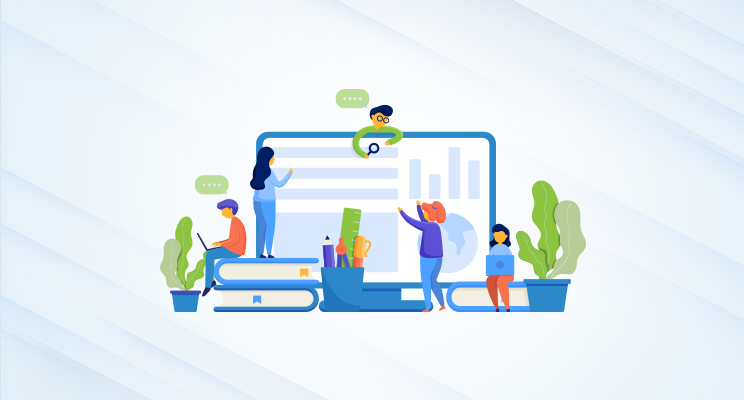All types of training and education require measurable and optimized assessments so institutions or organizations can evaluate the outcome of knowledge that has been imparted to the learner. Learners are encouraged to perform better when assessments are accurate, focused, and well-designed. Today, thanks to technology and the internet, computer-assisted assessments have almost replaced traditional testing approaches, which were more resource-intensive and time-consuming. A computer based test removes several logistical hassles by embracing the benefits of digital technology. Before we move ahead, let’s look at why we need a CBT exam.
The Need for a Computer Based test
There is no doubt that the pandemic caused many upheavals in the education sector. However, organizations also faced the brunt of these disruptions. This is possibly why most institutions are opting for a CBT exam in order to minimize the administrative challenge of scheduling a written exam, printing papers, and the laborious task of evaluating written answers. On the other hand, a CBT test only requires the test-taker who uses a computer, keyboard, or mouse to submit answers electronically. This client-server environment is fast, accessible, cost-effective, and stress-free. Let’s take a look at different ways in which a computer based exam can be successfully conducted and how you can get the best results from this investment.
1. Flexible Scheduling
One of the key disadvantages of traditional testing procedures is a lack of flexibility. Once an exam has been scheduled, there are a variety of activities that revolve around it. For instance, invigilators need to be arranged and brought to the venue. The classroom needs to be set up properly, and question papers need to be printed, etc. This kind of system does not allow for any unforeseen situations that may occur. In the event that the exam has to be cancelled, the institution stands to lose time, effort, and money. However, a computer based test can be easily rescheduled without any extra cost.
2. Anti-cheat Functions
Institutions can take advantage of several technical functions that will ensure that the candidate is unable to use unfair means to complete the CBT exam. For instance, even if there are twenty-five test-takers sitting in one room and working on the same exam, the questions can be shuffled so there is no room for copying or sharing of answers. Further, there are other options such as enabling firewalls, disabling the Internet connection, system freeze, frisking, etc.
3. Biometric Authentication
With exams getting more competitive, there is a possibility of others impersonating the test taken to secure higher marks. Fortunately, a CBT test prevents this from happening as biometric verification tools such as hand geometry, fingerprints, digital signatures, and voice waves can be used to ensure that the correct candidate is writing the exam. This goes a long way in preventing fraud and ensuring that the results are genuine.
4. CCTV Invigilation
Exams conducted in a classroom setup can be difficult to organize and manage as physical invigilators would need to be arranged to monitor the test-takers during the exam. These invigilators normally distribute the papers, hand out extra sheets, record signatures or timings, and collect the papers after the exam. On the other hand, a computer based test allows for invigilation through CCTV cameras. This makes the process much more streamlined and organized. The entire room can be monitored from one source without any disruption.
5. Webcam Invigilation
This is another option when conducting a CBT test, as it allows the webcam on the computer to capture an image of the test-taker while they are doing the exam. This ensures an added layer of security and prevents any misrepresentation or fraud. Webcam invigilation gives the institution or organization that is conducting the exam an extra bit of control even though they may not be physically present at the centre.
6. Multi-lingual Assessment
It is quite possible to have test-takers who speak and write different languages. They may wish to do the exam in a language of their choice. Printing question papers in different languages will be a tedious task, apart from being expensive and time-consuming. Further, any printed material will be prone to errors, and poor printing quality can affect the test-taker’s ability to complete the exam successfully. However, a CBT exam offers a vital advantage in this regard. The test-taker can easily choose the desired language and complete the exam using the digital medium.
7. Auto-grading
In traditional testing methods, the physical papers will need to be carefully graded, and marks have to be awarded accordingly. The human element to this process, unfortunately, leaves much scope for errors. The grades may also depend on how experienced the evaluators are, their mental state, mood, motivation, and prejudices. Further, it would take days or sometimes even weeks to complete the grading process and to generate accurate reports. Today, with a computer based test, many of these pitfalls can be avoided. A CBT test that is in a multiple-choice format can be auto-graded, and results can be published in minutes. This is especially useful to both candidates and the institution as it saves time in making critical decisions for the future. It would also be very easy to generate different kinds of reports based on what the institution wants to identify.
8. Complete Automation
The future of testing is quickly moving towards a world of complete automation. Test-takers prefer to be able to complete everything, from registration to evaluation, through the computer screen. There is also a lot of progress in the field of computer adaptive testing, where questions are posed to the test-taker based on his or her specific level of expertise, knowledge, or ability. These features would be almost unheard of in a pen-and-paper setting where every candidate is given the same paper irrespective of their aptitude. Innovations in computer based testing will make it more candidate-friendly and customizable so the best results are secured.
Digital technology offers us several functions and tools which can help test-takers to utilize their time and perform at an optimal level during the exam. The better the test environment, the better the chances of acing the test and getting accurate results. For an organization or institution, a robust CBT platform can help scale up testing practices without significant additional investment. The software will allow hundreds of test-takers to complete the exam at the same time without any glitches or errors. Whether it is for mock examinations, recruitment, or entrance exams, a CBT test has proven to work across industries. High-quality software, a proctored environment, superior infrastructure, and a qualified team of CBT specialists can help you take advantage of the digital test environment.




